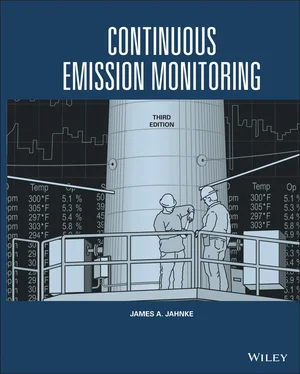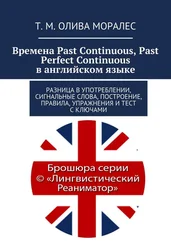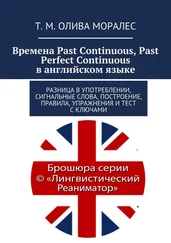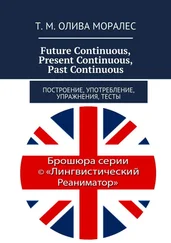James A. Jahnke - Continuous Emission Monitoring
Здесь есть возможность читать онлайн «James A. Jahnke - Continuous Emission Monitoring» — ознакомительный отрывок электронной книги совершенно бесплатно, а после прочтения отрывка купить полную версию. В некоторых случаях можно слушать аудио, скачать через торрент в формате fb2 и присутствует краткое содержание. Жанр: unrecognised, на английском языке. Описание произведения, (предисловие) а так же отзывы посетителей доступны на портале библиотеки ЛибКат.
- Название:Continuous Emission Monitoring
- Автор:
- Жанр:
- Год:неизвестен
- ISBN:нет данных
- Рейтинг книги:4 / 5. Голосов: 1
-
Избранное:Добавить в избранное
- Отзывы:
-
Ваша оценка:
- 80
- 1
- 2
- 3
- 4
- 5
Continuous Emission Monitoring: краткое содержание, описание и аннотация
Предлагаем к чтению аннотацию, описание, краткое содержание или предисловие (зависит от того, что написал сам автор книги «Continuous Emission Monitoring»). Если вы не нашли необходимую информацию о книге — напишите в комментариях, мы постараемся отыскать её.
The new edition of the only single-volume reference on both the regulatory and technical aspects of U.S. and international continuous emission monitoring (CEM) systems Continuous Emission Monitoring
Continuous Emission Monitoring:
Continuous Emission Monitoring, Third Edition
Continuous Emission Monitoring — читать онлайн ознакомительный отрывок
Ниже представлен текст книги, разбитый по страницам. Система сохранения места последней прочитанной страницы, позволяет с удобством читать онлайн бесплатно книгу «Continuous Emission Monitoring», без необходимости каждый раз заново искать на чём Вы остановились. Поставьте закладку, и сможете в любой момент перейти на страницу, на которой закончили чтение.
Интервал:
Закладка:
To be used effectively in any environmental program, CEM data must be representative, accurate, precise, and credible. In this regard, calibration, performance testing, certification testing, and periodic auditing are essential in maintaining credibility. An environmental agency monitoring strategy cannot be successful without including these elements.
Continuous monitoring requirements were first promulgated for fossil‐fuel‐fired steam generators in the United States in December 1971. In 1974, Germany passed the Federal Immission Control Act, which incorporated continuous monitoring requirements. Also, in 1974, pollutant emission limits and further monitoring requirements were published as “Technical Instructions on Air Quality Control” (TA‐Luft) in the Federal Republic of Germany. However, intensive monitor development did not begin until 1975 when the U.S. EPA published “performance specification procedures” for continuous emission monitors, and the German Federal Ministry of the Interior (BMI) published its corresponding “suitability testing guidelines.”
Since then, CEM regulations have expanded, affecting a wider range of sources and requiring a wider range of pollutants to be monitored. The basic CEM program elements established in the 1970s underlie most of the current regulations. The foundation of any regulatory continuous monitoring program incorporates three basic elements: (i) implementing rules, (ii) performance specifications, and (iii) quality assurance requirements. These three elements provide the necessary support for the application of CEM technology ( Figure 2‐1).
When placed on uneven surfaces of a wide range of industrial applications, agency regulatory policies must be robust enough to enable CEM systems to produce accurate data. Continuing this analogy, when taking a photograph, a tripod serves to provide a stable base for a camera; the sharpness of the picture depends on the quality of the tripod as well as the quality of the camera. In the same sense, the quality of the data produced by a CEM system is dependent on both the system and the elements that support it.
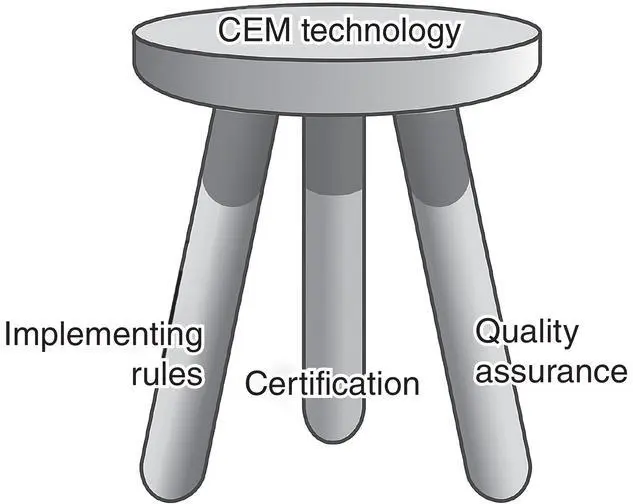
Figure 2‐1 CEM program elements.
Implementing rules address the source categories and types of units required to monitor emissions, whereas performance specifications provide design, installation, and certification criteria. Quality assurance (QA) requirements specify procedures necessary for obtaining accurate data on a continuing basis. These elements support a CEM program, and a failure in definition of any one element can lead to an ineffective or failed regulatory program. Each of these elements incorporates a number of integral parts, which are illustrated in Figure 2‐2.
The regulatory development of implementing rules, performance specifications, and quality assurance requirements are discussed later in this chapter. Details of performance specification, performance specification test procedures, and quality assurance programs are discussed in the dedicated chapters that follow.
IMPLEMENTING RULES IN THE UNITED STATES
Implementing rules specify the type of source affected by the rule and may further specify types of process units required to monitor emissions. For example, a Kraft pulp mill recovery furnace may be required to monitor opacity and total reduced sulfur (TRS), or a petroleum refinery sulfur recovery unit may be required to monitor SO 2and H 2S emissions through an implementing rule.
The rule should also specify why monitoring is required – its purpose. This may not always be stated or may be ill‐defined, particularly in permits. However, distinctions are important in the case of litigation. Purposes for which CEM systems are typically installed are as follows:
Control equipment operation and maintenance monitoring
Compliance monitoring
Emissions accounting
Public perception monitoring
The first U.S. Federal CEM implementing rules required the installation of CEM systems to monitor the performance of emissions control equipment. Since CEM systems provide a continuous record that shows if a source is either below or above its emissions limits (emissions standards), it was soon noted that the data could also be used for enforcement purposes. Implementing rules followed that required the installation of CEM systems to be used directly for enforcement. Another purpose for the installation of CEM systems is to provide the data necessary to support emissions accounting programs, such as the EPA acid rain program. Pollutant and flow monitoring data are used in these programs to calculate emissions in units of tons per year. A regulatory instrument called an “allowance” is equivalent to a right to emit one ton per year of a given pollutant and a source must have in its possession, the number of allowances equal its mass emissions expressed in tons/year. Here, CEM systems are the measurement tool used to track allowances.

Figure 2‐2 Elements of a CEM rule.
Public perception monitoring (or more euphemistically, “good neighbor” monitoring) refers to more stringent monitoring requirements established for sources such as municipal and hazardous waste combustors. In this case, extensive monitoring requirements are specified, coupled with plant operational interlock criteria where waste feed is shut off if emission limits should be exceeded. The continual oversight given by this instrumentation is intended to provide assurances to the public that environmental concerns associated with these types of sources are being addressed.
In addition to addressing source categories, operational units, and monitoring purposes, implementing rules also specify source specific monitoring details, such as instrument span requirements, data conversion equations, averaging periods, quality assurance, and reporting requirements. These details are important for using the data, but are often overlooked, particularly in state permits. Although there is a greater awareness of the need to specify such requirements in the implementing rules, when they are not incorporated, the rule may be too ambiguous to fulfill its regulatory intent. The variety of implementing rules that require the installation of CEM systems are examined further in the following sections.
U.S. Federal Implementing Rules
U.S. federal stationary source emissions standards and monitoring requirements are drafted by offices of the Environmental Protection Agency. The most important of these is the Office of Air Quality Planning and Standards (OAQPS), which developed the first CEM implementing rules and performance specifications in the early 1970s (U.S. EPA 1975). Other EPA offices have instituted CEM programs based on the original OAQPS regulations, modifying them for their own regulatory applications. Figure 2‐3summarizes CEM regulatory programs that have been instituted.
In the United States, rules are first developed by the respective office and proposed in the Federal Register (FR), a document published on each government business day that includes regulatory proposals, promulgations, notices, and discussions concerning the rulemaking. After public hearings, comment, and revision, the regulations and requirements are promulgated and adopted into the U.S. Code of Federal Regulations (CFR). The CFR is a multivolume compendium of U.S. regulations for federal government agencies, which is revised annually to incorporate any new rules or changes in existing rules. It is the principle reference for environmental regulation in the United States.
Читать дальшеИнтервал:
Закладка:
Похожие книги на «Continuous Emission Monitoring»
Представляем Вашему вниманию похожие книги на «Continuous Emission Monitoring» списком для выбора. Мы отобрали схожую по названию и смыслу литературу в надежде предоставить читателям больше вариантов отыскать новые, интересные, ещё непрочитанные произведения.
Обсуждение, отзывы о книге «Continuous Emission Monitoring» и просто собственные мнения читателей. Оставьте ваши комментарии, напишите, что Вы думаете о произведении, его смысле или главных героях. Укажите что конкретно понравилось, а что нет, и почему Вы так считаете.
